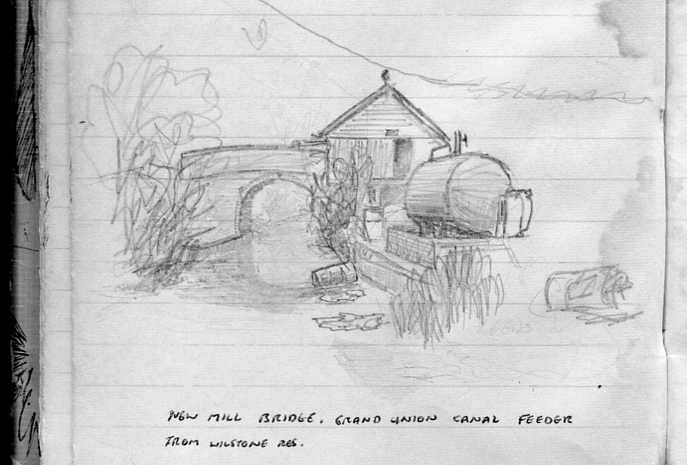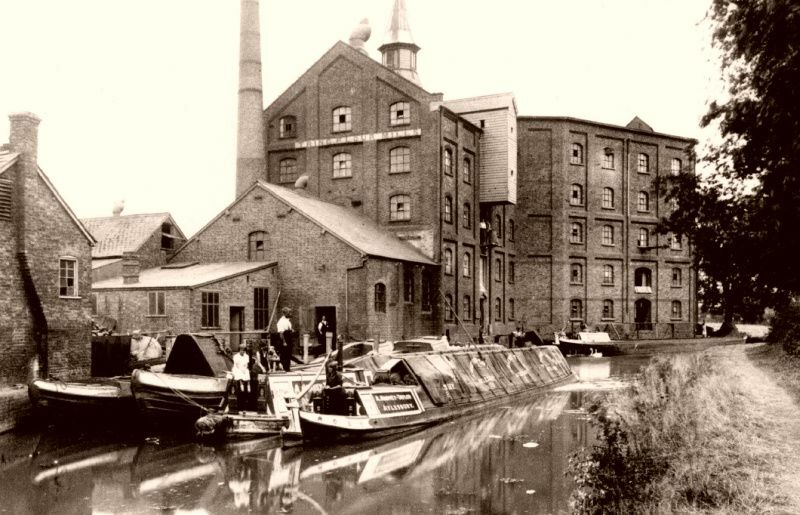-
Posts
4,943 -
Joined
-
Last visited
-
Days Won
1
Content Type
Profiles
Forums
Events
Gallery
Blogs
Store
Everything posted by Derek R.
-

Louthing Around - a brief tour of the Louth Canal
Derek R. replied to magpie patrick's topic in History & Heritage
Yes, there was a thread on that a short while back. Forgotten the lock name. -

Louthing Around - a brief tour of the Louth Canal
Derek R. replied to magpie patrick's topic in History & Heritage
Ths scolloped side walls are reminiscent of some on the Canal du Midi. -
A little more on this location: https://baldexplorer.com/saving-our-waterways/
-
I spy the sidecar wheel of a motorcycle and sidecar under the tarp . . .
-
I do not know the person, but the surname looks like Franz. The individual letters match others in the note, save the 'z', for which there is no comparison - except it's not a 'y'.
-
In the case of SPRY, I disagree. What "use" would that be? Certainly not carrying. Where she is now, she is in prime condition in a dedicated enclosed building with access to the public to view both inside and the entire hull shape from ground level, the latter which will never be seen if in the water. Plus there is the issue of being open to the elements afloat, and all the required extra maintenance that goes with keeping a wooden craft afloat - who pays for that? It's one of a kind, where it is now is possibly the best place for it. The romantic dreams of seeing them sailing? It goes with the possible cost of losing such craft forever simply due to maintenance costs and possible neglect - with the possibility it may end up on the bank again, seeking funds to restore and build a permanent covered housing. At Blists Hill, SPRY is one of a whole range of exhibits that can be enjoyed by the general public from a traditional Fish & Chip shop, candlemakers, horse bus, chemist, ironworks and more. Afloat, it may seem just another old barge in need of perpetual ritual docking - away from the public eye.
-
MP describes them well. But I have never considered a 'pound' to be the water between a set of gates at either end of a lock. Whilst when a set of gates are open, the water within the lock is 'part' of a pound, but when closed at both ends it is just a lockful of water taken from the upper pound to raise/lower craft. A Stop lock has gates both ends, and the rise is usually small. But a Stop lock cannot be just a single gate across a waterway, as you would need to lower the entire pound to pass through, wasting much water in the process. However, where single gates are installed, it is usually either side of an aqueduct, and in one case I have seen - a tunnel, which are correctly called Stop Gates, designed to be closed, or automatically closed by water flow, in the event of a breach.
-
Welcome David. As Aspley (the one I know quite well) is in Beds., I think you mean Apsley! Slip of the finger. SNOWDROP in action, swiftly followed by SICKLE. towing an 'opper. Late eighties, Berko.
-
Beverley! Where did I get Beryl from? Well, it starts with a B. (Poor excuse). Don't remember the Morris Minors, but I only appeared on the scene in '79.
-
Roger Alsop is correct. There's a lot more on PEARL (both of them, the ex Steamer formerly BARON & the TCO boat) in this older thread: Also mention of POYLE, the wooden boat that was Beryl's home at the time (early eighties), and which was the 'Welcoming' boat in Aylesbury basin.
-
Bug remover (from vehicle bodywork) would remove the residue but beware of what additives are within, though any cooking oil left to soak into the label will also do the job, even the natural oils from fingers will do it, but patience will be needed. Blimey David - that's a bit perfect! I'd be frightened to go near that one.
-
"A risky hobby"? It's a design to fit a purpose. Without my old Petter manual to hand (so working from memory and a little experience of wet and dry sump engines) you will find the PD2 a wet sump engine - there is no separate oil tank. In most wet sump engines, the crank rotates above the level of sump oil. Also, a crank thrashing around in oil is not the primary source of lubrication for main and big end bearings. 'Splash' lubrication was a common factor in more primitive engines before forced lubrication, early motorcycle engines spring to mind, and even the later Panther big single relied on splash lubrication for a long time. With the Petter, the oil pump forces oil through the oil cooler to bearings and the valve gear, mostly through external pipes which help to aid cooling from the forced air draught. Water jacketed engines do not run so hot, so many oilways are drillings through blocks, and piston to bore clearances are generally smaller than air cooled, the latter wider to allow for piston expansion under load. Edited to add: Some say that allowing the PD to run at slow speeds on tickover will exacerbate stress and fatigue on a crank, and that this may contribute to failure. Diesel engines do not like running slowly, even though the owners like it for the sound.
-
We had a PD2 that came out of a ships lifeboat. After installing it in YARMOUTH, we spent many years slogging around the system from Guildford to Gargrave, taking in the Thames and Trent. Never missed a beat. Straight through pipe - you could hear us coming. Get in a tunnel and the rythyms echoing from the tunnel roof from the exhaust would have you dancing on the back step. We'd heard about their cranks breaking, and one or two knowledgeable folk (ex-boatmen) had theories, including making them slog at low rpm, to poor starting techniques. Another suggested leaking oil coolers causing pressure drop. I always turned mine over a dozen times or so with the lifters up, hit the starter, drop the levers and she'd fire instantly, never failed. But one could not start her by hand, took two on the handle. Roger and I did it once. And I lost count of the times I'd forgotten to take the gas bottle cap off the exhaust to be followed by a clank on the roof as it landed, never accompanied by a splash oddly enough. Sold the boat in late '92, and within three months heard the crank had broke. The chap also had caused damage to the Z bar, doing something that forced the bar and tiller so far forward, he had to cut some wood off the tiller handle to clear the top of the hatches. I had heard that BW were offered a bunch of PD's from stationary sets to replace aging RN's, but don't know the truth in that. Maybe they were engines destined for landing craft and no longer required. 'Chip fryers', they weren't quiet mechanically being air cooled and much tinware. The three pot version in TYCHO. Sods to work on. PS: NOTE - the flywheel at the gearbox end. A PDV8 generator set (image courtesy of young Mr. Riches.) Bet that sounded good!
-
SPRY looks rather magnificent now, with staging alongside to view the interior. Blists Hill Village. https://www.nationalhistoricships.org.uk/register/606/spry
-
I tend to agree. The number looks to be 780?4, a 2-6-0 introduced in 1953, designed at Derby. Weight loco 49t 5cwt. 65 built in that class. Could be 78064, in which case it was the last in that series. Four are preserved: https://preservedbritishsteamlocomotives.com/2mt-78000-78064-2-6-0-br-standard-class-2/
-
What a fabulous film. Such a wide ranging view of life as it was, and as it changes. Great character. R.I.P. Alan Holden.
-
True. My piece was exposed to the elements. Big difference!
-
Had it been ply, it would have disintegrate long ago. This was painted on plywood in the 1980's, and photographed here 20yrs later.
-
The flag does sort of give it away.
-
Look on any colour chart and you will find many colours of grey, and many names of those colours. Black & White Cigarettes: https://www.iwm.org.uk/collections/item/object/30085118 Also a Whisky. PC my ar**.
-
Those brown scars on the fields reminds me of exactly the same patterns I saw in green fields just to the Northern edge of Kincraig, Inverness-shire. Within two years the entire field was a housing estate.
-
You certainly can see 'CREEPING JENNY' and ASH Roland. I think it was in 1983. I think JENNY had been lengthened at that point judging by the back cabin chimney and the engine'ole exhaust, and John 'lost' the 'creeping'.
-
Yes, we winded YARMOUTH at sixty some feet in the Silk stream (so called because it came down through the chalk esarpment and turned the mill wheel in the Silk Mill. Good history here: https://tringlocalhistory.org.uk/Silk_Mill/index.htm ). In one of my images Barry and Moira (of BREAM) are looking across to the flour mill, YARMOUTH is on the right, our dog 'Bert' is looking at John and Georgie's dog 'Domino', and in the other ACS meeting shot, John is seen striding along toward the camera engaged in banter with someone on a boat. This would be between 1983 and 1985 (I fancy 1983). Roger and Fran Wakeham's ASH is inside of the Pattle's JENNY.
-
Great stuff Courty. I lived in and around Tring and Wendover from 1969 through to 1980. I have swum across Wilstone, and legend has it there was a big Catfish in there! I remember the arm being closed off to boats, being very shallow and used only as a feeder. At New Mill the water was crystal clear and many fish were to be seen. It was in water up to Little Tring pumping station, the stop lock was completely filled in and the road bridge a solid embankment, only a shallow depression beyond gave any hint of the canal course. This was back when the New Inn at Buckland Wharf was still a working pub. and I drove RT's past to and from Aylesbury 'in service' on routes 301 and 706. More recently: https://tinyurl.com/2p85vdpc Further along near Wendover, there was a Wartime branch line that crossed the canal from Wendover Station to the RAF base at Halton. Images at New Mill: A quick pencil sketch I made in the seventies when the bottom was very close to the top! Later, when in water. Sometime in the eighties Much earlier Mid 1980's. The pumping Station, limit of navigation. Winding was done in the Silk Stream just beyond New Mill (much to the annoyance of a certain local resident). Prior to the clearing, the stop lock was not just filled in, the entire area was thick with shrub and brambles, such that this shot would not have been possible. Turning around, and standing on the then road bridge, the remains of the Arm curving around to the right
-
Heartland's looks like someone's back garden outhouse, and the other (Irish?) looks all the world like a contrived display - but where? Don't recall reading about narrow locks in Ireland. And that 'lock' looks way short. Who's EPA?



.jpg.ac3eb1e654a0450561a08828c6140edb.jpg)
.jpg.fb1f7714f4648b3c567c113df5e975e3.jpg)
.jpg.d794ff22f7d7938cd48c0588f2c5d828.jpg)
.jpg.ca869aa8dabd4d8d601c391deb7b8aaf.jpg)
.jpg.dd14ebd038b78d54b70af8b23767aef4.jpg)
.jpg.18d3556f9e3c7182b0d33e6dfddb8e46.jpg)


.jpg.7a5645c922f7ed938cce7a2acc3b98ed.jpg)
.jpg.6558f107f99d4d0e72ec9b5451433baa.jpg)
